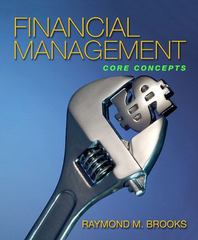

(W2.1) Let's suppose that you have new demand data that changes the original demand equation. Let's assume that our demand equation has the general form: D(q) = aq? + bq+c. For this set of data, then, with D(q) = 0.00035q? 0.08174 + 551 , we would have the following values. a= 0.00035 b= 0.0817 C= 551 What if c drops by 25, and so it changes from 551 to 526, so that the new demand equation is D2(q) = 0.00035q 0.0817q + 526 ? If we were to make this change, then for any value of q, the price per unit that you could charge when selling q items would be $25 lower for D2 (9) than it would be for D(q). So, now take D2 (q), as shown above, to be the new demand equation and then compute the following: A) What is the new quantity of items that will maximize profit? Answer: (Round to the nearest whole item) B) What is the new price per item that will maximize profit? To get your answer, use the rounded quantity in part A. (Why does that make sense?) Answer: (Round to the nearest cent/penny) C) What is the new maximum amount of profits you can earn with this new variable cost? To get your answer, use the rounded quantity in part A. Answer: (Round to the nearest DOLLAR) (W2.2) Now let's supposed that the c term in the demand equation goes up from 551 to 576. Now, your new demand equation would be D3(q) = -0.00035q 0.0817q+576 Compute the following: A) What is the new quantity of items that will maximize profit? Answer: (Round to the nearest whole item) B) What is the new price per item that will maximize profit? To get your answer, use the rounded quantity in part A. (Why does that make sense?) Answer: (Round to the nearest cent/penny) C) What is the new maximum amount of profits you can earn with this new variable cost? To get your answer, use the rounded quantity in part A. Answer: (Round to the nearest DOLLAR) (W2.1) Let's suppose that you have new demand data that changes the original demand equation. Let's assume that our demand equation has the general form: D(q) = aq? + bq+c. For this set of data, then, with D(q) = 0.00035q? 0.08174 + 551 , we would have the following values. a= 0.00035 b= 0.0817 C= 551 What if c drops by 25, and so it changes from 551 to 526, so that the new demand equation is D2(q) = 0.00035q 0.0817q + 526 ? If we were to make this change, then for any value of q, the price per unit that you could charge when selling q items would be $25 lower for D2 (9) than it would be for D(q). So, now take D2 (q), as shown above, to be the new demand equation and then compute the following: A) What is the new quantity of items that will maximize profit? Answer: (Round to the nearest whole item) B) What is the new price per item that will maximize profit? To get your answer, use the rounded quantity in part A. (Why does that make sense?) Answer: (Round to the nearest cent/penny) C) What is the new maximum amount of profits you can earn with this new variable cost? To get your answer, use the rounded quantity in part A. Answer: (Round to the nearest DOLLAR) (W2.2) Now let's supposed that the c term in the demand equation goes up from 551 to 576. Now, your new demand equation would be D3(q) = -0.00035q 0.0817q+576 Compute the following: A) What is the new quantity of items that will maximize profit? Answer: (Round to the nearest whole item) B) What is the new price per item that will maximize profit? To get your answer, use the rounded quantity in part A. (Why does that make sense?) Answer: (Round to the nearest cent/penny) C) What is the new maximum amount of profits you can earn with this new variable cost? To get your answer, use the rounded quantity in part A. Answer: (Round to the nearest DOLLAR)








